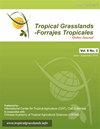Effects of growth stage on nutritional value of barley and triticale forages for goats
IF 0.9
4区 农林科学
Q3 AGRICULTURE, DAIRY & ANIMAL SCIENCE
引用次数: 0
Abstract
The nutritional composition and in vitro gas production of barley and triticale forages at tillering, stem elongation, and ear emergence stages were studied. The mean crude protein (CP), neutral detergent fiber (NDF) and water-soluble carbohydrate (WSC) content was higher in barley than triticale. The supplementation of wheat grain in in vitro incubation had no effect on the gas production of barley and triticale forage. The nutritive value of barley and triticale forages is highly influenced by growth stage and is high during the early stage of growth during tillering and stem elongation. Barley and triticale forages have potential as feed for dairy goats and although barley had a higher CP content, both have adequate ME and CP levels to meet the nutritional requirements of adult goats with 50 kg body weight in early lactation.生长阶段对山羊大麦和小黑麦饲料营养价值的影响
研究了大麦和小黑麦在分蘖期、茎伸长期和出穗期的营养成分和体外产气量。大麦的平均粗蛋白质(CP)、中性洗涤纤维(NDF)和水溶性碳水化合物(WSC)含量高于小黑麦。体外培养中添加小麦籽粒对大麦和小黑麦饲料产气量无影响。大麦和小黑麦牧草的营养价值受生育期影响较大,分蘖和茎伸长生长初期营养价值较高。大麦和小黑麦饲料有潜力作为奶山羊的饲料,虽然大麦的粗蛋白质含量较高,但两者均具有足够的代谢能和粗蛋白质水平,可满足50 kg体重的成年山羊泌乳早期的营养需求。
本文章由计算机程序翻译,如有差异,请以英文原文为准。
求助全文
约1分钟内获得全文
求助全文
来源期刊

Tropical Grasslands-Forrajes Tropicales
Agricultural and Biological Sciences-Agronomy and Crop Science
CiteScore
1.60
自引率
0.00%
发文量
36
审稿时长
16 weeks
期刊介绍:
The Journal publishes, in English or Spanish, Research Papers and Short Communications on research and development, as well as contributions from practitioners (Farmer Contributions) and Review Articles, related to pastures and forages in the tropics and subtropics. There is no regional focus; the information published should be of interest to a wide readership, encomprising researchers, academics, students, technicians, development workers and farmers.
In general, the focus of the Journal is more on sown (''improved'') pastures and forages than on rangeland-specific aspects of natural grasslands, but exceptions are possible (e.g. when a submission is relevant for a particularly broad readership in the pasture and forage science community).
The Journal will also consider the occasional publication of associated, but closely related, research in the form of an additional scientific communication platform [e.g. a re-make of the former Genetic Resources Communication series of the former Division of Tropical Crops and Pastures of the Commonwealth Scientific and Industrial Research Organisation (CSIRO), Australia].
Areas of particular interest to the Journal are:
Forage Genetic Resources and Livestock Production[...]
Environmental Functions of Forages[...]
Socio-economic Aspects[...]
Topics within the aforementioned areas may include: Diversity evaluation; Agronomy; Establishment (including fertilization); Management and utilization; Animal production; Nutritive value; Biotic stresses (pests and diseases, weeds); Abiotic stresses (soil fertility, water, temperature); Genetics and breeding; Biogeography and germplasm collections; Seed production; Ecology; Physiology; Rhizobiology (including BNF, BNI, mycorrhizae); Forage conservation; Economics; Multilocational experimentation; Modelling.
 求助内容:
求助内容: 应助结果提醒方式:
应助结果提醒方式:


